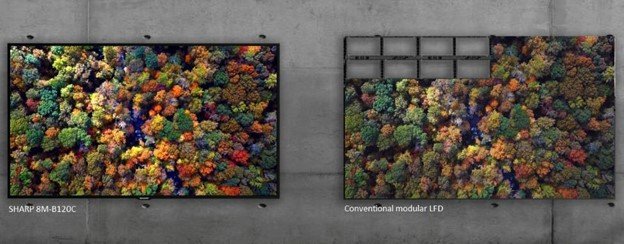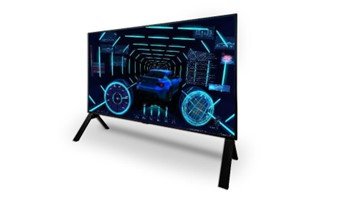Are you looking to upgrade your television and enter the next generation of the ultra-high-definition viewing experience? 8K displays are the latest and most excellent way to enjoy content with higher resolution, contrast, brightness, and colors. But when it comes to buying an 8k display, there are a few things that need to be taken into consideration.
If you want a TV with a high-resolution display, be pleased as here we have come up with a useful guide for you about an 8k display. This guide will cover all aspects of buying an 8K TV so you can confidently choose the best one for your needs.
The resolution of 8K TVs has been getting a lot of attention lately, but that’s not the only resolution that professional monitors use. In fact, many have been using this resolution for years. The resolution is used on monitors that are used by people who work with photos or videos. They need to see everything clearly, and they don’t want any pixels to get in the way. There are multiple 8k Tv displays available in the market for users who love high-resolution such as SHARP 8M-B120C. It offers amazing features to the viewers with an ultra-fine 0.3mm pixel pitch available in the Middle East and Africa. You can check out this limited-edition 120” 8K display here www.ultralargedisplay.com.

What is 8k?
8K is a resolution higher than 4K, and that’s it – but this answer does not do justice to the range of advantages 8K has over its predecessor. 8K, also known as Ultra High Definition. It is the highest resolution currently available, boasting an impressive 7680 x 4320 pixels – four times more than 4K. This means images appear sharper and clearer with finer details than ever before, making 8K ideal for both large-scale home TV viewing and professional filmmaking projects.
Moreover, while 1080p screens have a resolution of 1,920 by 1,080 pixels and 4K screens double those numbers to 3,840 by 2160, 8K offers a much greater level of detail with 33 million pixels per frame compared to just 2 million for Full HD.
Features on 8k Displays

AI Processors
They are powered by processors that have the ability to support 8K resolutions. This means that you can now find 8K displays in a variety of different forms, from laptops and desktop computers to even smart TVs.
HDR Content
All 8K displays use a technology called High Dynamic Range (HDR) to provide a smoother image and richer sound. HDR works by taking multiple pictures of the same scene and merging them together, so the colors and details are more accurate. This makes movies look more lifelike and provides a better listening experience for music, games, and other audio content.
Sound System
8K display also comes with built-in speakers that are capable of providing an excellent listening experience. If you’ve got an 8K TV, you’ll be able to enjoy the clear sound without any interference from room noise or other external sources.
HDMI Ports and Wi-Fi
When it comes to connecting various devices to an 8K TV, the HDMI port is king. Nearly every 8K TV on the market has at least one HDMI port, making it easy to connect your computer, game console, or other compatible devices. Additionally, many 8K TVs also come with Bluetooth 4.2 and Wi-Fi connectivity, allowing you to easily stream content from streaming services like Netflix or Amazon Prime Video without having to use a cable connection.

Uses of 8K Displays
8K displays offer some of the highest resolution technology available today. As a result, 8K displays are primarily used for scientific research and for artistic work. From vibrant artwork to detailed architectural diagrams, 8K screens are perfect for creating art due to their unparalleled levels of detail. This can be especially useful in the entertainment industry, where filmmakers require an incredibly high level of image quality in order to create authentic and immersive experiences.
Regarding scientific research, 8K displays provide scientists with detailed images that enable them to analyze data down to a microscopic level. For example, medical researchers can use 8K screens to observe intricate details within cells that may not be visible with other forms of imaging technology. Medical facilities are also utilizing these 8K displays for medical imaging applications such as MRIs, and CT scans to obtain more accurate diagnosis results.
Furthermore, astronomers can identify stars and galaxies that would otherwise remain undetected due to their small size or low-intensity light emission.
NASA is using them to view high-resolution images of planets and stars. 8K displays are four times sharper than 4K displays and sixteen times sharper than full HD 1080p resolution. They enable scientists to get a much clearer look at the details of these celestial objects from millions of light years away.
These 8K displays are being used to create detailed maps with an unprecedented accuracy of things like the gravitational field around black holes or gas clouds between stars.
8K technology is proving invaluable across multiple industries, giving researchers greater insight into space exploration and providing better diagnoses for medical patients.
Gamers are betting that 8KTVs will be widespread in the future. This is because 4K TVs have been available for a few years now, and game developers have started to create games that can be played on them. However, 8K TVs offer a much crisper image than 4K TVs, which makes them perfect for gaming. In fact, many game developers are creating games specifically for 8KTVs because they know that there is a great demand for them.
Final Thoughts
8K displays are the latest and greatest advancement in the world of television, offering an incredibly immersive viewing experience with unparalleled resolution. Their massive 8K resolution provides a level of detail that has never been seen before. With manufacturers beginning to release 8K TVs, now is the perfect time to take advantage of these revolutionary products. Whether you’re watching movies or playing games, 8K displays will bring your entertainment to life like never before. So what are you waiting for?




